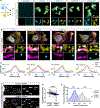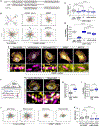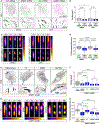G3BP1 ribonucleoprotein complexes regulate focal adhesion protein mobility and cell migration
- PMID: 39883578
- PMCID: PMC11923778
- DOI: 10.1016/j.celrep.2025.115237
G3BP1 ribonucleoprotein complexes regulate focal adhesion protein mobility and cell migration
Abstract
The subcellular localization of mRNAs plays a pivotal role in biological processes, including cell migration. For instance, β-actin mRNA and its associated RNA-binding protein (RBP), ZBP1/IGF2BP1, are recruited to focal adhesions (FAs) to support localized β-actin synthesis, crucial for cell migration. However, whether other mRNAs and RBPs also localize at FAs remains unclear. Here, we identify hundreds of mRNAs that are enriched at FAs (FA-mRNAs). FA-mRNAs share characteristics with stress granule (SG) mRNAs and are found in ribonucleoprotein (RNP) complexes with the SG RBP. Mechanistically, G3BP1 binds to FA proteins in an RNA-dependent manner, and its RNA-binding and dimerization domains, essential for G3BP1 to form RNPs in SG, are required for FA localization and cell migration. We find that G3BP1 RNPs promote cell speed by enhancing FA protein mobility and FA size. These findings suggest a previously unappreciated role for G3BP1 RNPs in regulating FA function under non-stress conditions.
Keywords: CP: Cell biology; CP: Molecular biology; G3BP1; RNA localization; cell migration; focal adhesions; protein mobility; ribonucleoprotein complexes.
Copyright © 2025 The Authors. Published by Elsevier Inc. All rights reserved.
Conflict of interest statement
Declaration of interests S.W. is a co-inventor on a patent applied for by Harvard University related to the MERFISH technology. S.W. is a shareholder and consultant of Translura, Inc. M.H. is a current employee of Merck Research Laboratories.
Figures







References
Publication types
MeSH terms
Substances
Associated data
- Actions
- Actions
- Actions
Grants and funding
LinkOut - more resources
Full Text Sources
Research Materials
Miscellaneous

